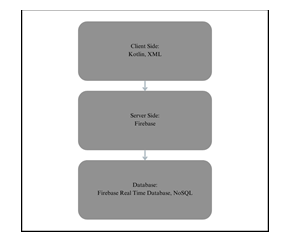Ijraset Journal For Research in Applied Science and Engineering Technology
- Home / Ijraset
- On This Page
- Abstract
- Introduction
- Conclusion
- References
- Copyright
A Kotlin and Firebase Based Project Discovery Platform with Cosine Similarity-Based Recommendation
Authors: Prof. Avinash A. Utikar, Tejas S. Gaikwad, Nitin S. Dhavan, Deepak B. Singh, Khushabu B. Chaudhari
DOI Link: https://doi.org/10.22214/ijraset.2024.60556
Certificate: View Certificate
Abstract
In today\'s interconnected world, mobile applications have become integral to our daily lives, revolutionizing how we communicate, work, and collaborate. we present an Android application utilizing Kotlin, Firebase, and a cosine-based recommendation system to address the challenge of project collaboration and discovery. The application aims to provide users with a seamless and personalized experience, empowering them to discover, collaborate on, and contribute to projects aligned with their interests and expertise. By integrating Firebase, the application ensures real-time data synchronization, secure authentication, and cloud storage capabilities, enhancing user experience. The implementation of a cosine-based recommendation system further enhances project discovery by analyzing user profiles and project data to generate personalized recommendations. This paper offers insights into the architecture, methodology, and implementation details of the Android application, highlighting its innovative features and technologies for collaborative project management.
Introduction
I. INTRODUCTION
In today's interconnected world, mobile applications have become an integral part of our daily lives, revolutionizing the way we communicate, work, and collaborate. With the rapid advancement of technology, the demand for innovative mobile solutions that cater to the diverse needs of users continues to grow. In this context, our paper focuses on the development of an Android application leveraging Kotlin, Firebase, and a cosine-based recommendation system. This application aims to address the challenge of project collaboration and discovery by providing users with a seamless and personalized experience. By harnessing the power of modern technologies and advanced algorithms, our project seeks to empower users to discover, collaborate on, and contribute to projects aligned with their interests and expertise.
The Android application serves as a gateway for users to explore a diverse range of projects, connect with like-minded individuals, and engage in meaningful collaboration. Through the integration of Firebase, the application offers real-time data synchronization, secure authentication, and seamless cloud storage capabilities, ensuring a smooth and reliable user experience. Additionally, the implementation of a cosine-based recommendation system enhances project discovery by analyzing user profiles and project data to generate personalized recommendations tailored to each user's preferences and skills. This paper provides insights into the architecture and implementation details of the Android application, highlighting the innovative features and technologies employed to create a powerful and intuitive platform for collaborative project management.
II. LITERATURE SURVEY AND KEY LEARNINGS
- Choices and Usages of Collaboration Tools in Remote Software Teams: a study on the selection and utilization of collaboration tools within remote software teams, especially amidst the shift to remote work accelerated by the COVID-19 pandemic. It reveals that teams rely on communication, artifact management, and task management tools, facing challenges due to fragmented information across multiple platforms. Additionally, it highlights the importance of tailored tools and niche solutions.[1]
- Web-Based Communication: Android-Based Chat Application: This paper discusses the significance of communication and collaboration in computer science, informatics, and education, emphasizing the role of effective networking for innovation. It mentions the International Conference on Computer Communication and Informatics as a forum for professionals to exchange ideas.
It underscores the impact of technology on communication processes, productivity, and success, advocating for resource provision, technology integration in education, and continuous professional development.[2]
3. Collaborative Filtering Algorithms and Personalization: paper presents an advanced collaborative filtering algorithm for recommendation systems, improving accuracy by analyzing user behavior, implementing time-interest weight function, and considering user preference and trust. It highlights experimental results demonstrating the algorithm's superiority over traditional approaches in providing personalized recommendations.[3]
4. Personalized Research Paper Recommendation Systems: This paper introduces a personalized research paper recommendation system called UserProfile-based PRPRS. It describes an algorithm for keyword extraction and inference, continuously updating user profiles based on collected research papers to enhance recommendation accuracy. It evaluates the system's performance, indicating high satisfaction and accuracy in recommending research papers.[4]
5. Challenges in Virtual Teams: A literature review on collaboration in virtual teams, focusing on factors and challenges associated with distance and other contributors. It categorizes factors affecting virtual teams, such as geographic and temporal distance, trust, and motivation. Challenges hindering distance work, including awareness of colleagues and maintaining motivation, are discussed, along with opportunities for research in resolving collaboration discrepancies and work culture issues.[5]
III. METHODOLOGY
A. Technologies

B. Kotlin Programming Language
Kotlin is the primary programming language used for Android app development. It offers concise syntax, null safety, and seamless interoperability with Java, making it a preferred choice for building modern Android applications. Kotlin's features such as coroutines also facilitate asynchronous programming, simplifying tasks like network requests and background processing.
C. Firebase
Firebase is a comprehensive mobile development platform provided by Google, offering a suite of backend services to support app development. The application utilizes various Firebase services:
D. Firebase Realtime Database
A cloud-hosted NoSQL database that provides real-time data synchronization across clients. It's used to store and sync user profiles, project data, and recommendations.
Firebase Authentication: Provides secure user authentication and authorization using email/password, social logins (e.g., Google Sign-In), and other authentication methods.
Firebase Cloud Storage: Offers scalable cloud storage for media files, such as images and videos, used in the application.
Firebase Cloud Messaging: Enables sending push notifications to users to engage and re-engage them with the application.
E. Cosine Similarity Algorithm
const functions = require('firebase-functions');
const admin = require('firebase-admin');
const { cosineSimilarity } = require('cosine-similarity');
admin.initializeApp();
exports.recommendProjects = functions.https.onCall(async (data, context) => {
const { userId, userSkills } = data;
// Get user skills (assuming skills are stored as an array in Firestore)
const userDoc = await admin.firestore().collection('users').doc(userId).get();
const userSkillsVector = userDoc.data().skills.map(skill => skill.toLowerCase());
// Query projects with matching skills (assuming tags are stored as an array in Firestore)
const querySnapshot = await admin.firestore()
.collection('projects')
.where('skills', 'array-contains-any', userSkills)
.get();
const recommendedProjects = [];
querySnapshot.forEach(projectDoc => {
const project = projectDoc.data();
const projectTagsVector = project.tags.map(tag => tag.toLowerCase());
const similarity = cosineSimilarity(userSkillsVector, projectTagsVector);
recommendedProjects.push({ id: project.id, name: project.name, similarity });
});
// Sort recommended projects and filter by minimum similarity (optional)
recommendedProjects.sort((a, b) => b.similarity - a.similarity);
const minSimilarity = 0.5; // Adjust as needed
const filteredProjects = recommendedProjects.filter(project => project.similarity >= minSimilarity);
return { projects: filteredProjects };
});
The recommendation system in the application utilizes cosine similarity algorithms to generate personalized project recommendations for users. Cosine similarity measures the cosine of the angle between two vectors in a multidimensional space, representing the similarity between items (in this case, projects) based on their attributes (e.g., skill tags, project descriptions). This algorithm helps identify similar projects and suggest relevant ones to users based on their interests and skills.
IV. IMPLEMENTATION AND RESULTS
A. Project Creation
The project creator initiates the process by creating a new project on the platform.
They provide details such as project title, description, required skills, project goals, and any additional information or attachments related to the project.
B. Project Posting
Once the project details are entered, the project is posted on the platform for other users to view.
The project is displayed in the project feed or search results, making it visible to potential collaborators.
C. User Interaction
Users interested in the project can view the project details, including its description, required skills, and goals.
They can express their interest in the project by submitting a proposal outlining their skills, experience, and reasons for wanting to join the project.
D. Proposal Submission:
Interested users submit proposals through the platform, indicating their desire to collaborate on the project.
They may attach additional documents, such as resumes or portfolios, to support their proposals.
E. Proposal Review:
The project creator reviews the proposals submitted by users to evaluate their suitability for the project.
They assess factors such as the applicant's skills, experience, compatibility with project goals, and alignment with the project's vision.
F. Proposal Approval:
After reviewing the proposals, the project creator selects the most suitable candidates to join the project.
They may approve multiple proposals or select a single applicant, depending on the project's needs and the quality of the submissions.
G. Communication and Collaboration:
Upon approval, the selected applicants are added to join the project team and group chat for the project.
A group chat or messaging channel is created for the project team members to communicate, share updates, and collaborate effectively.
The project creator and team members can discuss project details, assign tasks, and coordinate efforts to progress the project toward its goals.


Conclusion
the project discovery platform for collaborative project development outlined herein offers a comprehensive solution for connecting project creators with potential collaborators and facilitating effective project management and collaboration. By leveraging technologies such as Kotlin, Firebase, and cosine-based recommendation algorithms, the platform provides a seamless user experience and empowers users to discover, join, and contribute to meaningful projects. the future scope of the project includes scalability improvements, additional features, integration with emerging technologies, and ongoing optimization based on user feedback and evolving industry trends. By continuously evolving and adapting to user needs, the platform aims to become a vital tool for fostering innovation, collaboration, and creativity across diverse project domain
References
[1] Jackson, A. Van Der Hoek, and R. Prikladnicki, “Collaboration Tool Choices and Use in Remote Software Teams: Emerging Results from an Ongoing Study,” in Proceedings - 15th International Conference on Cooperative and Human Aspects of Software Engineering, CHASE 2022, Institute of Electrical and Electronics Engineers Inc., 2022, pp. 76–80. doi: 10.1145/3528579.3529171. [2] S. Shukla, S. C. Gupta, and P. Mishra, “Android-Based Chat Application Using Firebase,” in 2021 International Conference on Computer Communication and Informatics, ICCCI 2021, Institute of Electrical and Electronics Engineers Inc., Jan. 2021. doi: 10.1109/ICCCI50826.2021.9402510. [3] R. Ji, Y. Tian, and M. Ma, “Collaborative Filtering Recommendation Algorithm Based on User Characteristics,” in 2020 5th International Conference on Control, Robotics and Cybernetics, CRC 2020, Institute of Electrical and Electronics Engineers Inc., Oct. 2020, pp. 56–60. doi: 10.1109/CRC51253.2020.9253466. [4] K. Hong, H. Jeon, C. J.-2012 8th international conference on, and undefined 2012, “UserProfile-based personalized research paper recommendation system,” ieeexplore.ieee.orgK Hong, H Jeon, C Jeon2012 8th international conference on computing and networking, 2012•ieeexplore.ieee.org, Accessed: Mar. 12, 2024. [Online]. Available: https://ieeexplore.ieee.org/abstract/document/6418639/ [5] S. Morrison-Smith and J. Ruiz, “Challenges and barriers in virtual teams: a literature review,” SN Appl Sci, vol. 2, no. 6, Jun. 2020, doi: 10.1007/s42452-020-2801-5.
Copyright
Copyright © 2024 Prof. Avinash A. Utikar, Tejas S. Gaikwad, Nitin S. Dhavan, Deepak B. Singh, Khushabu B. Chaudhari. This is an open access article distributed under the Creative Commons Attribution License, which permits unrestricted use, distribution, and reproduction in any medium, provided the original work is properly cited.

Download Paper
Paper Id : IJRASET60556
Publish Date : 2024-04-18
ISSN : 2321-9653
Publisher Name : IJRASET
DOI Link : Click Here
 Submit Paper Online
Submit Paper Online

